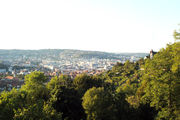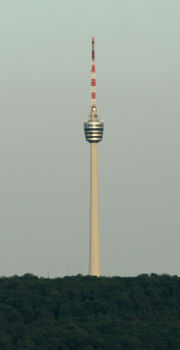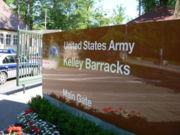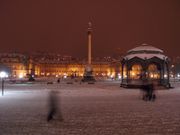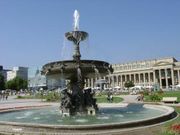Stuttgart
2007 Schools Wikipedia Selection. Related subjects: Geography of Great Britain
| Stuttgart | |
|---|---|
 |
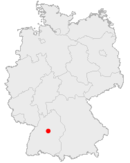 |
|
|
|
| Country | Germany |
| State | Baden-Württemberg |
| Administrative region | Stuttgart |
| District | urban district |
| Population | 591,528 source (2006) |
| Area | 207.36 km² |
| Population density | 2,853 / km² |
| Elevation | 207-549 m |
| Coordinates | 48°47′ N 9°11′ E |
| Postal code | 70001-70629 |
| Area code | 0711 |
| Licence plate code | S |
| Mayor | Wolfgang Schuster ( CDU) |
| Website | stuttgart.de |
Stuttgart [ˈʃtʊtgaʁt], located in southern Germany, is the capital of the state of Baden-Württemberg with a population of 591,528 (as of April 2006) in the city and 2.7 million in the metropolitan area.
Overview
Stuttgart, Germany, the capital of Baden-Württemberg state (pop. 11 million, 36,000 square kilometers) and the Administrative Region of Stuttgart (pop. 4 million, 11,000 km²), is located in the centre of the very densely populated southwestern Stuttgart Region (population 2.7 million, 3,700 km²) of Germany, close to both the Black Forest and the Swabian Jura. The city centre (situated in a lush valley, ringed with vineyards and forests, close to the River Neckar) itself has a population of 591,528 (as of 30 April 2006) and covers an area of 207 km². Stuttgart with its metropolitan area (the political entity " Stuttgart Region" enlarged by the nearby cities of Ludwigsburg, Böblingen, Esslingen, Waiblingen, Göppingen and their respective districts [kreise]) is one of the most prominent and well-known German towns, especially due to its cultural, administrative and huge economic importance.
Stuttgart is the sixth largest city in Germany and Stuttgart Region is the nation's fourth largest conurbation (behind Ruhr Area, Rhein/Main Area and Berlin). Neighbouring large cities are Frankfurt (210 km north of Stuttgart), Nuremberg (200 km northeast of Stuttgart) and Munich (220 km southeast of Stuttgart).
The City of Stuttgart is subdivided into 23 city districts, among the most well-known are:
- Bad Cannstatt (Western Europe's largest mineral spas / Zoo Wilhelma / " Cannstatter Wasen" and " Stuttgarter Frühlingsfest" on the Cannstatter Wasen)
- Moehringen (Musical Theaters)
- Stammheim (High-security court & jail, see RAF terrorists)
- Untertürkheim ( DaimlerChrysler HQ and Original Mercedes-Benz plant)
- Vaihingen (One of two campuses of Stuttgart's university, not to be confused with nearby Vaihingen(Enz))
- Zuffenhausen (Home of the Porsche Sports Cars Company)
- Feuerbach (Home of original Bosch plant)
Stuttgart is also the seat of a protestant bishop (Protestant State Church of Württemberg) and one of the two co-seats of the bishop of the Roman Catholic diocese Rottenburg-Stuttgart. The pentecostal Biblische Glaubens-Gemeinde ist the largest megachurch in Germany.
History
The coat of arms shows a black, rampant horse on a yellow or golden field. It is a canting seal due to the fact that the name "Stuttgart" is an over the centuries modified version of "Stutengarten", in English roughly "mare garden" or "stud farm". About 950, Stuttgart was originally founded by Duke Liudolf of Swabia, one of the sons of the Holy Roman Emperor Otto I the Great, and used for horse breeding (especially for his father's cavalry, see Battle of Lechfeld). Later on (about 1300), Stuttgart became the residence of the counts of Württemberg. In 1496, the counts of Württemberg were promoted to dukes by the emperor of the Holy Roman Empire. After Napoleon's breakup of the Holy Roman Empire, the dukes of Württemberg earned the title of kings and Stuttgart became a royal residence.
The name of the royal family of Württemberg and of the state originates from a steep Stuttgart hill, formerly known as Wirtemberg, nowadays called Württemberg. On top of that hill, the mausoleum from 1824 of Queen Katharina (daughter of Czar Paul I of Russia) and King Wilhelm I of Württemberg is located.
During the revolution of 1848/1849, a democratic pan-German national parliament ( Frankfurt Parliament) was formed in Frankfurt to overcome the division of Germany. After long discussions, the parliament decided to offer the title of German Emperor to the Prussian king. Since the democratic movement became weaker, the German princes regained control of their independent states. Finally the Prussian king declined the revolutionaries' offer. The members of parliament were driven out of Frankfurt, and the most radical members (those who wanted to establish a republic) fled to Stuttgart. A short while later, this rump parliament was dissolved by the Württemberg military.
In 1871, as an autonomous kingdom, Württemberg joined the German Empire or Kaiserreich, created by the Prussian prime minister Otto von Bismarck through several successful wars and diplomacy. After World War I, the monarchy broke down and the Free State of Württemberg was established, as a part of the Weimar Republic. In 1920, Stuttgart was the seat of the German National Government (since the administration had to flee from Berlin, see Kapp Putsch). During World War II, the city centre of Stuttgart was nearly completely destroyed due to Allied air raids.
In 1945 the Allied Forces took control of Germany. They merged parts of the former German States of Baden and Württemberg and later in 1952 on the new, democratic state Baden-Württemberg (3rd largest German state) with Stuttgart as its capital was created by a referendum.
After World War II, an early concept of the Marshall Plan to support the reconstruction and economic/political recovery of Europe was presented during a speech given by US Secretary of State James F. Byrnes at the Stuttgart Opera House ( September 6, 1946). This speech led directly to the unification of the British and American occupation zones, resulting in the so called bi-zone. Two years later, the French also joined the bi-zone, creating the tri-zone and thereby paving the way for the foundation of the Federal Republic of Germany. Stuttgart, like Frankfurt, was a serious contender to become the federal capital, but finally Bonn succeeded.
In the late seventies, the city district of Stammheim was centre stage of one of the most controversial periods of German post-war history: The Red Army Faction trial at the Stammheim high-security court and the subsequent suicides of Ulrike Meinhof, Andreas Baader, Gudrun Ensslin and Jan-Carl Raspe (all imprisoned in the Stammheim jail). The trial and the period thereafter were accompanied by several new terroristic assaults to liberate the inmates ( German Autumn 1977: i.a. the abduction and murder of the German industrialist and President of the German Employers' Association Hanns Martin Schleyer resp. the hijacking of Lufthansa flight LH181, redirecting the jet to Mogadishu).
During the Cold War, the joint command centre of all United States military forces in Europe, Africa and the Atlantic was moved to Stuttgart (US European Command, EUCOM). EUCOM is still headquartered there today.
U.S. Army bases in and around Stuttgart include or included the following: Patch Barracks (HQ EUCOM), Robinson Barracks, Kelley Barracks (General Patton's son once lived there), and Panzer Kaserne.
In the past American dependent schools, affiliated with either the United States Dependents Schools Europe (USDESEA) or Department of Defense Education Activity Schools (DODDEAS), included Stuttgart American High School ( Pattonville); Stuttgart Elementary and Junior High Schools (Robinson Barracks); Patch American High School (Patch Barracks); and Boeblingen Elementary School (Panzer Kaserne). American high school sports teams from Stuttgart would play against American high schools in Frankfurt, Kaiserslautern, Wiesbaden, and sometimes Munich, an international high school. In 1994 Pattonville, and subsequently Stuttgart American High School were returned to the local German governance.
Economy
Approximately 150,000 companies are located in the Stuttgart region. The area is known for its high-tech industry; some of its most prominent companies include DaimlerChrysler, Porsche, Bosch, Celesio, Hewlett-Packard and IBM all of whom located their world or German headquarters here. In fact, the Porsche badge, as seen on the front of Porsche cars has this town's name in the centre of the badge, something that is unique amongst the world's vehicle makers. A theory even suggests that also the Ferrari logo " Cavallino Rampante" had its origin in the Stuttgart coat-of-arms. Stuttgart is the place where the motorbike and the four-wheeled automobile were invented (invented by Gottlieb Daimler and Carl Benz, industrialised 1887 by Gottlieb Daimler and Wilhelm Maybach in their 1887 Daimler Motoren Gesellschaft), it's hence the starting point of the worldwide automotive industry. Such famous and prestigious brands as Mercedes-Benz, Porsche and Maybach are produced there. Also the very first prototypes of the eventual VW Beetle were fabricated in Stuttgart, based on a design by Ferdinand Porsche.
The region currently has Germany's highest density of scientific, academic and research organizations, and tops the national league for patent applications. More than 11% of all R&D-expenses in the Federal Republic of Germany are generated in the Stuttgart Region (approximately 4.3 billion Euro per year). In addition to several universities and colleges, the area has six institutes of the Fraunhofer Gesellschaft, four institutes for collaborative industrial research at local universities, two Max-Planck Institut, as well as one large-scale research centre—the German Aerospace Centre (DLR).
Stuttgart holds top place of all European Union regions according to the share of employment in high-tech and medium-high tech manufacturing with a figure of 21.0% (2001 data from Eurostat).
The Stuttgart Stock Exchange is the second largest in Germany (only behind Frankfurt) and important financial companies are headquartered in Stuttgart (e.g. Allianz Life Insurance, LBBW Bank or Wüstenrot), as well. In addition to these global players, the Stuttgart economy consists of many highly versatile and dynamic medium-sized enterprises (the so-called " Mittelstand").
Furthermore, Stuttgart is still one of Germany's largest wine-growing towns with a century-long tradition and is situated at the geographic centre of the "Württemberg Wine Growing Area" (110.30 km², one of 13 official German growing areas, according to the German Wine Law).
Stuttgart is also home to Dinkel-Acker Brewing Co.
Public transportation
Stuttgart, like other cities in Germany, is served by a regional rapid transit system called the S-Bahn. The S-Bahn trains operate on the rails of the Deutsche Bahn AG and are powered with normal traction current (single phase AC, 15 kV/16.67 hertz) taken from overhead wires. Stuttgart also has a light rail system ( Stadtbahn in German) which has incrementally replaced the city's tram lines. It runs with DC with a voltage of 750 volts and uses normal gauge. In the city centre as well as in other densely built-up districts of the city, the Stadtbahn runs underground; hence the "U"-symbol for U-Bahn is used to signify it. Because the old tram lines used metre gauge, some of the light rail system's trackage still has three rails.
A peculiarity of Stuttgart is the Zahnradbahn, a rack railway operating from Marienplatz in the heart of the city to the Degerloch district; it is the only urban rack railway in Germany and is powered by electricity. Furthermore, there is a cable car that operates in the city's Heslach district to the forest cemetery (Waldfriedhof), employing cars built of wood. On the Killesberg, a prominent hill in the city, there is a park railway run by diesel (and on weekends with steam), which makes roundtrips through the Killesberg Park. At the forest hostel of the city's public transport provider, there is a small electric tram for children called "Rumpelstilzchen", which is closed to tourists.
People, culture, and architecture
Stuttgart is known for its cultural life, in particular the Staatstheater and Staatsgalerie. The Staatstheater contains an opera house and three smaller theaters, where opera, ballet, theatre and concerts are produced. The world-renowned Stuttgart Opera won the prestigious "Opera of the year" (Germany/Austria/Switzerland) award for five years running (1998-2002). The famous Stuttgart Ballet is connected to names like John Cranko and Marcia Haydée. The city also offers two broadway-style Musical theaters, the Apollo and the Palladium Theatre (each approx. 1800 seats).
Stuttgart is home to ten institutes of higher education, the largest being University of Stuttgart, University of Stuttgart Hohenheim, Stuttgart Media University and University of Applied Sciences Stuttgart.
Stuttgart's city centre was heavily destroyed during World War II. During the reconstruction of the city in the style of the 1950s and 1960s many surviving historic buildings were demolished, e.g. the Kronprinzenpalais at Schlossplatz. The city today is thus poor in historic buildings. Nevertheless, many historic buildings have been reconstructed, and the city boasts of some fine pieces of modern post-war architecture.
- 1200 - 1600 Collegiate Church (Stiftskirche; Exterior: Romanesque/ Gothic); Interior: Romanesque/Gothic/Modern); reconstructed with simplified interior
- 1300 - 1500 Old Palace (Altes Schloß; Renaissance Style); reconstructed
- 1700 - 1800 New Palace (Neues Schloß; Baroque / Classicism); reconstructed with modern interior
- 1700 - 1800 Castle Solitude (Baroque / Rococo);
- 1850 King's Building (Königsbau; Classicism); reconstructed
- 1910 Market Hall ( Art Nouveau);
- 1920 Main Railway Station (Pre-Modern);
- 1927 Weissenhof Estate ( International Style);
- 1950 TV Tower (World's First concrete TV Tower);
- 1980 New State Gallery ( Neue Staatsgalerie; Postmodern);
- 2000 Stuttgart Airport Terminal Building (Modern) - located just outside the city in neighboring Leinfelden-Echterdingen
- 2005 Kunstmuseum Stuttgart (Modern).
In 1992, the VfB Stuttgart (a leading Bundesliga football team) claimed the first German Championship title after the reunification of the football federations of West and East Germany. The city also has a reputation for organizing other major sports events. It hosted the 1993 World Championships in Athletics and many other world and European championships of all kind of sports. The town was one of the twelve hosts of the Football World Cup 2006. I.a. the 3rd and 4th place playoff of the World Cup was held at the City's Daimler Stadium. Stuttgart also is " European Sports Capital 2007" and will host the 2007 UCI World Cycling Championships Road Race and Time Trials for elite men, women, and under-23 year old riders.
Stuttgart has also one real football stadium, about 100 hundred meters away from the TV tower. It's called GAZI Stadion auf der Waldau and the Stuttgarter Kickers as well as the American Football team Stuttgart Scorpions play there.
Stuttgart's Swabian cuisine, beer and wine (produced in the area since the 1600s) are also well known. The Gaisburger Marsch, a stew, was invented in Stuttgarts district Gaisburg. There are two famous annual beer festivals; the " Cannstatter Volksfest" on the " Cannstatter Wasen" and the slightly smaller " Stuttgarter Frühlingsfest" - However, both are second only in size to the Oktoberfest in Munich. The Christmas Market of Stuttgart is the largest and one of the oldest and most beautiful in Europe, especially renowned for the abundant decorations.
The famous " Wilhelma" is Germany's only combined zoological and botanical garden. The whole compound was built around 1850 as a summer palace in moorish style for King Wilhelm I of Württemberg. Close to the Wilhelma, there are the Stuttgart city districts of Bad Cannstatt and Berg which are the second largest mineral spas in Europe (only surpassed by Budapest).
Other important towns in the Stuttgart Region are Ludwigsburg with its enormous baroque palace, Sindelfingen and Esslingen.
Stuttgart Town Hall
The Stuttgart Town Hall is a highrise-building desined by Paul Schmohl and Pal Stohrer in 1956 with a 61 metre tall clock tower. Stuttgart Town Hall has a paternoster elevator. It was renovated in 2004. Stuttgart Town Hall has a bell that plays Swaebian Folk songs at 11:06 am, 12:06 pm, 2:36 pm and 6:36 pm.
Site
- Marktplatz 1
- 70173 Stuttgart
- Geographical coordinates: 48°46′30" N, 09° 10′ 41" E
Weblinks
- http://www.architekten24.de/projekt/rathaus-stuttgart/uebersicht/2569/index.html
- http://www.stgt.com/stuttgart/rathausd.htm
Famous people from Stuttgart
Notable people born in Stuttgart or residents who influenced the history of the city:
- Günther Behnisch - architect
- Robert Bosch - inventor (founded the Robert Bosch GmbH)
- Gottlieb Daimler - inventor of the motorbike and automobile, founded what would become Mercedes-Benz
- Dominic Dobson, race car driver
- Wilhelm Maybach - inventor together with Gottlieb Daimler
- Ferdinand Porsche - creator of the VW Beetle, founder of the Porsche car company
- Roland Emmerich - film producer, director and writer
- Georg Wilhelm Friedrich Hegel - philosopher
- Theodor Heuss - First German Post-War President
- Jürgen Klinsmann - football player, former coach of the German football squad
- Hermann Lang - Grand Prix race car driver
- Fritz Leonhardt - structural engineer
- Frei Otto - architect
- Friedrich von Schiller - famous German poet
- Peter Schilling - popular musician and Neue Deutsche Welle artist
- Count Stauffenberg - member of the German Resistance who tried to kill Hitler
- Richard von Weizsäcker - German President, Lord Mayor of Berlin
- Bernard Tomic - Tennis child prodigy
Sister cities


 Cardiff, Wales, United Kingdom, since 1955
Cardiff, Wales, United Kingdom, since 1955
 St. Louis, USA, since 1960
St. Louis, USA, since 1960
 Strasbourg, France, since 1962
Strasbourg, France, since 1962
 Mumbai (formerly known as Bombay), India, since 1968
Mumbai (formerly known as Bombay), India, since 1968 Menzel Bourguiba, Tunisia, since 1971
Menzel Bourguiba, Tunisia, since 1971
 Cairo, Egypt, since 1979
Cairo, Egypt, since 1979
 Łódź, Poland, since 1988
Łódź, Poland, since 1988
 Ogaki', Gifu Prefecture, Japan, since 1988
Ogaki', Gifu Prefecture, Japan, since 1988
 Brno, Czech Republic, since 1989
Brno, Czech Republic, since 1989
 Samara, Russia, since 1992
Samara, Russia, since 1992
